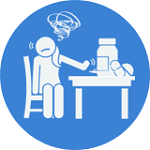What is self-neglect?
Gibbons (2006) defined self-neglect as:
The inability (intentional or non-intentional) to maintain a socially and culturally accepted standard of self-care with the potential for serious consequences to the health and wellbeing of the self-neglecters and perhaps even to their community.
Self-neglect can be a result of:
- a person's injury, dementia or other mental disorder, a learning disability
- obsessive compulsive disorder or hoarding disorder
- physical illness which influences ability, energy levevls, attention span, organisational skills or motivation
- reduced motivation as a side effect of medication
- addictions such as drugs, alcohol or gambling
- traumatic experiences
Self-neglect may start when they become mentally or physically unwell, or older and frailer. Those who are homeless or living in temporary accommodation may also be at greater risk.
Potential signs of self-neglect

Personal care
Very poor personal hygience and unkempt appearance. They lack essential food, clothing or shelter.

Living conditions
Living in squalid or unsanitary conditions and neglecting household maintenance.

Poor health
Unwillingness or inability to take medication or treat illness or injury. Person may be malnourished or dehydrated, have untreated injuries, and refusing offers of support.

Hoarding
Long-term hoarding behaviours, with an inability to throw away items without experiencing fear and anxiety.
Self-neglect can sometimes include hoarding behaviour. Professionals will come across different types of concerning environments and it is important to fully understand a person’s situation first, because people can have cluttered homes without having a hoarding disorder.
The NHS summarises hoarding disorder as "where someone acquires an excessive number of items and stores them in a chaotic manner. The items can be of little or no monetary value and usually result in unmanageable amounts of clutter."
Hoarding is now widely considered as a mental health disorder and in 2017 the World Health Organisation added Hoarding Disorder as a new category under obsessive compulsive disorder (Code: 42.3). The main difference between a hoarder and a collector is that hoarders have strong emotional attachments to their objects which are well in excess of their real value.
Many hoarders will never seek help themselves and are often difficult to treat. They may deny that there is a problem, rationalise the situation and, or display a low motivation to change.
Listen to Keith’s story to understand more about how hoarding can impact on an individual (Birmingham SAB).

Poor environment and personal hygiene
Poor environment and personal hygiene could arise as a result of:
- a cognitive impairment
- poor eyesight
- functional or financial constraints
- or neglect by others
Many people who self-neglect may also lack the ability and, or confidence to come forward and ask for help.
